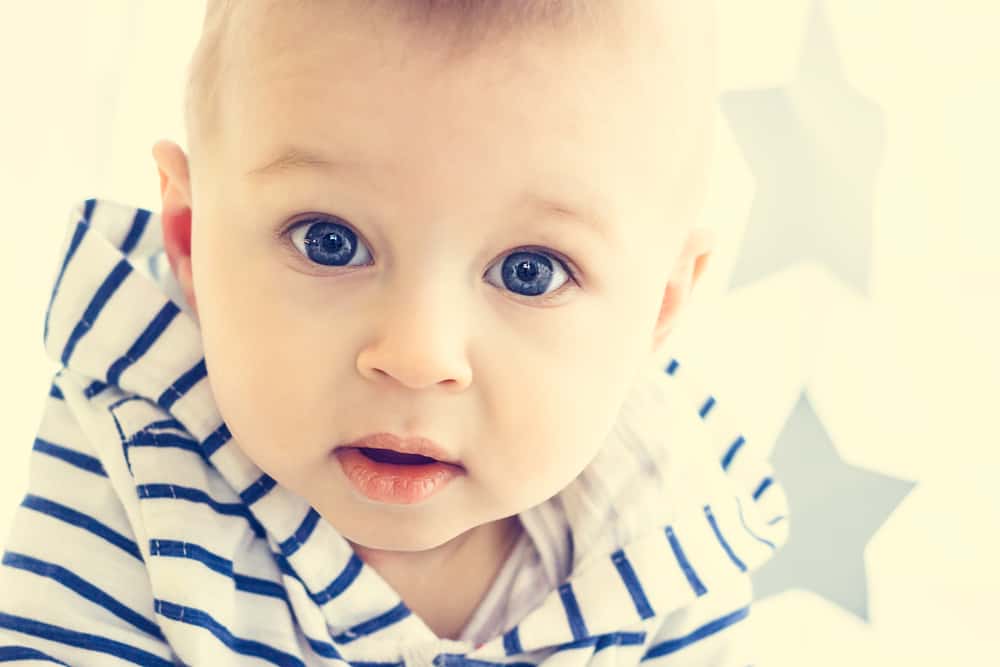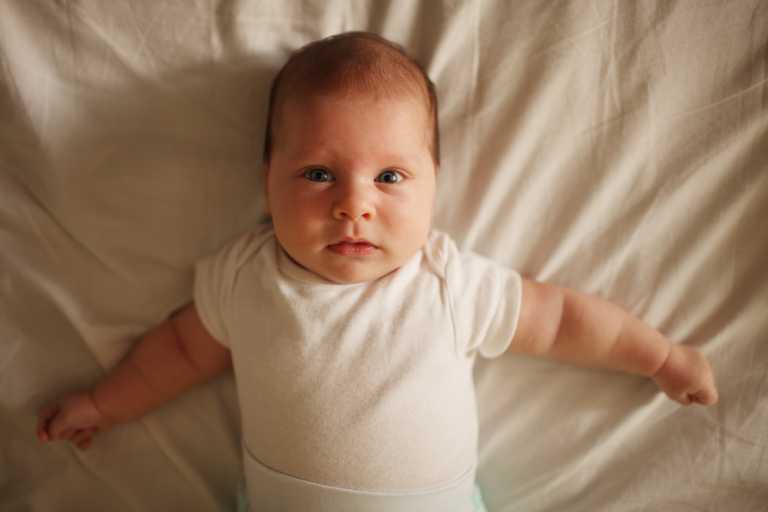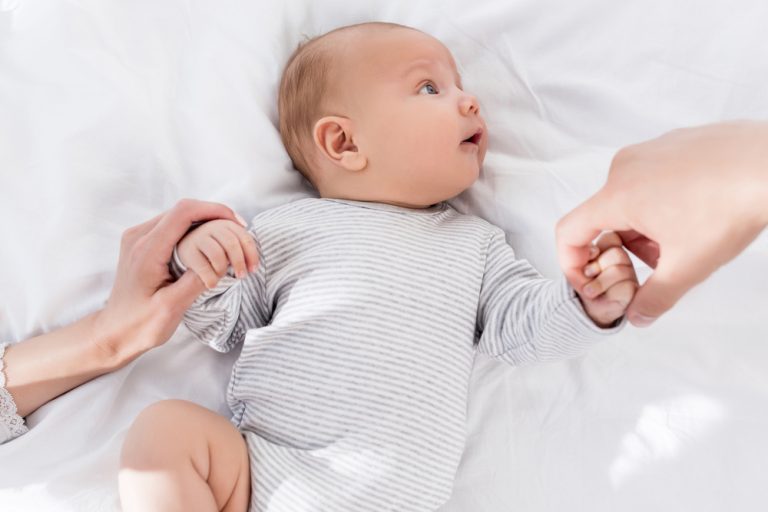There’s a crazy myth going around that all babies are born with blue eyes. But talk to a group of five moms, and four will tell you their baby had brown eyes at birth.
So, how has the blue-eyed thing become such a popular misconception? It’s down to an incredible phenomenon that means babies’ irises can change color up to a year after birth.
But why does it happen? Can you predict it? And is there a way to know what color your little one’s eyes will end up?
Let’s find out.
Why Are Babies Often Born With Blue Eyes?
Babies can be born with blue eyes for one of two reasons:
1. Genetics
The colored part of the eye is called the iris, and it’s made up of 2 layers. People with brown eyes have brown pigment in both layers, giving the eyes their color.
People with blue eyes only have pigment in the back layer (the pigment epithelium), and, strangely, it’s brown. However, the iris will still appear blue for the same reason we see the sky or ocean as blue.
When light enters the eye, fibers in the outer layer (the stroma) scatter and absorb the longer wavelengths of light. The shorter wavelength, blue light, is reflected back out, which is what we see. This is why blue irises can take on different shades in different lighting.
So, if a baby’s genetics mean they lack pigment in the stroma, they will always have blue eyes.
Interestingly, all blue-eyed people share one common ancestor. A European from between 6,000 and 10,000 years ago who had a genetic mutation that caused less pigment in their irises.
2. Lack of Melanin
The brown pigment in the iris is melanin, which is responsible for the coloration of both our eyes and skin.
This protective pigment is made by cells called melanocytes. These activate in response to light, so they serve as a crucial defense against the sun’s rays.
In the womb, babies’ irises aren’t exposed to light, so the melanocytes don’t produce much melanin. This means babies can be born with blue eyes even if it’s not in their genetics.
Will Your Baby’s Eyes Stay Blue?
If your little one’s eyes are genetically blue, they will stay this way for life.
However, as only 8% of the world’s population have blue eyes, it’s far more likely they’ll change.
This is because once your baby is born, light will enter their irises and activate those melanocytes. This will trigger melanin production, filling the stroma with brown pigment and changing their eye color.
If the stroma becomes filled with pigment, their irises will be brown. If only a moderate amount of pigment is produced, the brown and blue will interact, resulting in green or hazel.
When Do Babies Eyes Change Color?
If your baby’s irises are going to change, it’ll likely happen in the first 6 months to 1 year. But it can take several years for them to settle on their final color.
How Do You Know if Your Baby’s Eyes Will Change Color?
So how do you know if your little one’s baby blues are going to stick around? Unfortunately, it’s not possible to tell just by looking at them.
However, there are a few clues you can look out for. Here’s a quick checklist to help you make your prediction:
More Likely to End up Blue:
- You and your partner both have blue eyes.
- One or more of your baby’s grandparents have blue eyes.
- Your baby’s irises are a very light, bright blue.
- Your baby is Caucasian, meaning they have some European heritage.
More Likely to End up Brown or Hazel:
- You and your partner both have brown eyes.
- There are no blue eyes in your little one’s immediate family.
- Your baby was born with brown, black, or slate gray irises.
- Your little one has African or Asian ancestry.
Where Does Babies’ Eye Color Come From?
In the past, geneticists put the color down to two genes. One is responsible for the amount of melanin in the iris, and one is responsible for the activity of the melanocytes.
Predicting a child’s eye color based on two genes seemed simple enough, and they actually used it as a form of paternity test.
But, when people noticed that faithful blue-eyed couples were having brown-eyed babies, the geneticists realized something was up.
We now know that eye color is determined by 16 different genes as well as the structure of the iris. This means that even if you know the eye color of the parents and grandparents, you still can’t predict which your baby will inherit.
Can a Baby Have Blue Eyes if Their Parents Don’t?
As some of the genes for blue irises are recessive, a brown-eyed parent can carry them and pass them on to their child. This means that it is possible for two brown-eyed parents to have a blue-eyed baby.
In fact, if both brown-eyed parents carry one of the main blue-eyed genes, there’s a 25% chance the baby will have blue irises. However, if only one parent carries the recessive gene, the odds drop to 1%.
So if you and your partner have brown irises and your little one has been born with blue, don’t assume they will change.
FAQs
Which Parent Determines Eye Color?
Your baby’s eye color is inherited from a mixture of both mom’s and dad’s genes, even their recessive ones. So, working out your child’s future eye color is more complex than just looking at yours and your partner’s.
Can a Baby Get Blue Eyes From Grandparents?
Yes, grandparents can pass down a recessive blue-eyed gene. This means that blue can disappear from a family and pop up a few generations later.
Can Babies’ Blue Eyes Get Lighter?
No, the general rule is that your little one’s irises will only ever get darker, not lighter. This is because as light enters their eyes, it triggers melanin production, which darkens them.
Why Are My Baby’s Eyes Two Different Colors?
Heterochromia is a beautiful phenomenon that means a person’s irises are two different colors.
There are three different types that you might see:
- Partial – Only part of one iris is different.
- Central – The inner ring of the iris is different from the outer ring.
- Complete – One iris is different from the other.
In the majority of cases, people with heterochromia experience no problems with their health.
Unfortunately though, it can also be a sign of an underlying condition or rare disease. So it’s important to visit an ophthalmologist if you notice that your child has heterochromia.




